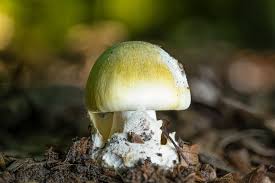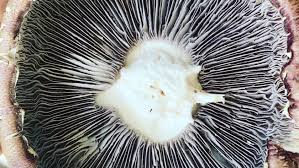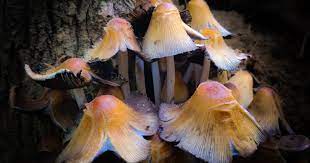Economic Importance, Uses, and By-Products of Mushroom Cap
Mushroom Cap also known as the pileus, is the uppermost part of a mushroom fruiting body. It is the visible, rounded, and often umbrella-shaped portion of the mushroom that sits atop the stem, known as the stipe. The cap is one of the most distinctive features of a mushroom and plays a crucial role in the identification of different species.
The size, color, shape, and texture of the mushroom cap can vary significantly depending on the species. Mushroom caps can range from just a few millimeters in diameter to several inches wide. They come in various colors, including white, brown, red, yellow, orange, and even more exotic shades like blue or purple. Some mushroom caps have smooth surfaces, while others may be covered in scales, warts, or other distinctive patterns.
Underneath the mushroom cap, you will typically find the gills (lamellae), which radiate from the central stalk (stipe) like spokes on a wheel in many mushroom species. The gills are where the mushroom’s spores are produced and released, aiding in the reproduction of the fungus.
It is essential to pay attention to the characteristics of the mushroom cap, along with other features like the stipe, spore color, and habitat, to accurately identify the species and distinguish edible mushrooms from toxic ones. Mushroom caps are not only a vital part of the mushroom’s life cycle but also a fascinating and diverse component of the natural world, with countless species exhibiting unique shapes, colors, and patterns.
Economic Importance, Uses, and By-Products of Mushroom Cap

Mushroom caps, the fleshy, umbrella-like structures of mushrooms, hold significant economic importance and have various uses across different industries. Below are some of the economic importance and uses of mushroom caps:
1. Culinary Uses: Mushroom caps are a popular ingredient in the culinary world, prized for their unique flavors, textures, and versatility. They are used in a wide range of dishes, including soups, salads, stir-fries, pasta dishes, and as toppings on pizzas and burgers. Some well-known culinary mushrooms with valuable caps include Portobello mushrooms, Shiitake mushrooms, and White Button mushrooms.
2. Commercial Farming: The cultivation of mushroom caps is a lucrative business. Numerous species are grown on commercial farms, contributing to the overall agricultural economy. Farmers carefully cultivate mushrooms under controlled conditions, ensuring optimal growth and quality for the market. This has led to the establishment of mushroom farms globally.
Read Also : Economic Importance, Uses, and By-Products of Cocoa/Cacao Stamens
3. Medicinal and Nutritional Value: Some mushroom caps have significant medicinal properties and are used in traditional medicine and supplements. For example, the Reishi mushroom (Ganoderma lucidum) is known for its potential immune-boosting properties, while Shiitake mushrooms (Lentinula edodes) contain compounds that may support heart health. The nutritional value of mushrooms includes being a good source of vitamins, minerals, and dietary fiber, making them valuable additions to a balanced diet.
4. Biotechnology and Bioremediation: Mushroom caps are used in biotechnology applications, especially in the field of bioremediation. Certain mushroom species have the ability to break down and absorb various pollutants and contaminants from the environment. They can be used to clean up oil spills, industrial waste, and other toxic substances, making them valuable allies in environmental conservation efforts.
5. Food Processing and Preservation: Mushroom caps can be processed into various forms, such as dried, canned, pickled, or frozen. These processed mushroom products have longer shelf lives, allowing for wider distribution and utilization beyond their fresh form. They can be found in supermarkets, restaurants, and food products like canned soups and sauces.
6. Cosmetics and Skincare: Extracts from mushroom caps are used in the cosmetics and skincare industry due to their potential benefits for skin health. Mushrooms contain compounds like polysaccharides and antioxidants that may help nourish and protect the skin, leading to their incorporation into skincare products like creams and serums.
7. Biodegradable Packaging: Researchers have been exploring the use of mushroom caps as a sustainable alternative to traditional packaging materials like Styrofoam and plastic. The mycelium, the thread-like structure of the mushroom, can be used to create biodegradable and eco-friendly packaging materials, reducing the environmental impact of conventional packaging.
8. Culinary Tourism and Recreation: Regions known for unique or rare mushroom species often attract culinary tourists and mushroom enthusiasts. Mushroom foraging, or “mushroom hunting,” has become a recreational activity in some areas, providing economic opportunities for local communities through tourism and nature-based experiences.
9. Value-Added Products: Mushroom caps are not only consumed in their fresh or processed forms but are also used to create value-added products. For example, mushroom extracts can be used as natural food flavorings and colorants in the food industry. Additionally, mushroom-derived compounds may be used in the production of supplements, herbal medicines, and nutraceuticals.
10. Animal Feed: Mushroom caps that are not suitable for human consumption due to size, appearance, or quality can be repurposed as animal feed. They provide a nutritious and cost-effective feed source for livestock and pets, reducing waste and benefiting the animal husbandry industry.
11. Research and Development: Scientists and researchers study mushroom caps to understand their chemical composition, biological properties, and potential applications. This research can lead to the discovery of new compounds with commercial applications, including pharmaceuticals, food additives, and industrial materials.
12. Employment and Job Creation: The cultivation, processing, and distribution of mushroom caps create employment opportunities for a diverse workforce. Mushroom farms require skilled labor for cultivation, harvest, and quality control, providing jobs for local communities and contributing to rural economies.
13. Export and Trade: Mushroom caps are traded internationally, and countries with suitable climates and expertise in mushroom farming may become significant exporters. This contributes to foreign trade and exchange of agricultural products, strengthening economic ties between nations.
14. Culinary Innovation: Chefs and food entrepreneurs continually explore innovative ways to use mushroom caps in dishes, creating new food trends and recipes. This culinary innovation not only drives customer interest and demand but also stimulates growth in the foodservice industry.
15. Research and Education: The study of mushroom caps also extends to educational and academic institutions. Researchers, students, and educators study various aspects of mushrooms, including their biology, taxonomy, and ecology. This research enhances our understanding of fungal ecosystems and contributes to ecological knowledge and conservation efforts.
16. Environmental Applications: Apart from bioremediation, mushroom caps have other environmental applications. They can be used in composting and organic waste management, aiding in the breakdown of organic materials and enriching soil with nutrients.
17. Traditional and Cultural Significance: In some cultures, certain mushroom species and their caps hold religious, ceremonial, or cultural significance. This can lead to tourism opportunities, cultural exchanges, and the preservation of traditional knowledge related to mushrooms.
18. Art and Craft Supplies: Dried mushroom caps, with their unique shapes and textures, are used as art and craft supplies. They can be incorporated into various artistic projects, adding a natural and organic touch to artworks, decorations, and handicrafts.
In conclusion, mushroom caps have a wide range of economic importance and uses, from their culinary appeal and medicinal properties to their applications in biotechnology, packaging, and environmental conservation. Their value extends beyond traditional consumption, making them valuable resources for multiple industries and contributing to sustainable economic growth and development.
The Products and By-products That Can Be Derived From Mushroom Cap

Mushroom caps, the fleshy, umbrella-like tops of mature mushrooms, can be used to produce various products and by-products through different processes. Here are some of the possibilities:
1. Fresh Culinary Product: The most obvious use of mushroom caps is as a fresh ingredient in culinary dishes. They are commonly used in salads, stir-fries, soups, omelets, and as pizza toppings. Mushrooms add a unique umami flavor to dishes and have a meaty texture when cooked.
Example: Sauteed mushroom caps with garlic and herbs served as a side dish.
2. Dried Mushrooms: Mushroom caps can be dried to extend their shelf life and concentrate their flavor. Dried mushrooms are a popular culinary ingredient and can be rehydrated before use in various dishes, sauces, and broths.
Example: Dried shiitake mushroom caps used in Asian soups and stews.
3. Mushroom Powder: After drying, mushroom caps can be ground into a fine powder. Mushroom powder can be used as a seasoning or flavor enhancer in a wide range of dishes, providing an intense mushroom flavor.
Example: Mushroom powder sprinkled on popcorn or used in spice blends.
4. Mushroom Extracts: By extracting the soluble compounds from mushroom caps using solvents or hot water, mushroom extracts can be obtained. These extracts are often used for their potential health benefits and as natural flavorings.
Example: Reishi mushroom extract used in dietary supplements for its supposed immune-boosting properties.
5. Mushroom Seasonings and Condiments: Mushroom caps can be processed into various seasonings, sauces, and condiments, enhancing the taste of different foods.
Example: Mushroom-based soy sauce used as a savory dipping sauce.
6. Mushroom Chips and Snacks: Thinly sliced mushroom caps can be dehydrated or baked to create crispy mushroom chips or snacks, offering a healthier alternative to traditional potato chips.
Read Also : Colorful Flowers: All You Need To Know About
Example: Crispy oyster mushroom chips seasoned with spices.
7. Compost and Fertilizer: Mushroom caps, along with other mushroom waste, can be used to produce nutrient-rich compost or fertilizer. This organic matter is beneficial for soil health and can be used in gardening and agriculture.
Example: Composting mushroom caps along with kitchen scraps and yard waste.
8. Animal Feed: Mushroom caps can be incorporated into animal feed formulations, providing a nutritious supplement for livestock and poultry.
Example: Mushroom caps used in livestock feed to improve animal health.
9. Biodegradable Packaging Material: Researchers are exploring the use of mushroom-based materials to create biodegradable packaging alternatives. The mycelium, the vegetative part of the fungus, can be utilized to produce biodegradable packaging materials.
Example: Mushroom caps and mycelium-based packaging used for shipping fragile items.
10. Industrial Uses: Certain types of mushrooms can be used in bioremediation to help clean up contaminated environments. They can absorb and break down pollutants, making them useful in industrial and environmental applications.
Example: Mushroom caps used in bioremediation efforts to clean up oil spills.
11. Medicinal Products: Certain mushroom species, like the medicinal mushrooms (e.g., Reishi, Chaga, Cordyceps), have been used in traditional medicine for their potential health benefits. Mushroom caps can be processed to extract bioactive compounds and used in various medicinal products.
Example: Mushroom cap extracts incorporated into herbal supplements for immune support.
12. Cosmetics and Skincare: Mushroom extracts, especially those with antioxidant and anti-inflammatory properties, are finding their way into the cosmetics and skincare industry. They are used in various products like creams, serums, and face masks.
Example: Mushroom-derived skincare serum for its purported skin-rejuvenating properties.
13. Biofuel and Bioplastics: Researchers are investigating the potential of mushroom caps to be used in biofuel production or as a source of biodegradable bioplastics.
Example: Mushroom caps used in bioreactors to produce biofuels.
14. Mycoremediation: In addition to bioremediation, mushroom caps and mycelium can be used in mycoremediation, a process that involves using fungi to break down and remove various environmental pollutants.
Example: Mushroom caps deployed to clean up toxic waste sites and polluted water bodies.
15. Fermented Products: Mushroom caps can be fermented to create unique and flavorful products like pickles, kimchi, or sauerkraut.
Example: Fermented mushroom cap pickles as a tangy and probiotic-rich snack.
16. Food Colorants: Certain mushroom species contain natural pigments that can be extracted and used as food colorants in the food industry.
Example: Mushroom cap-derived pigment used to add a natural color to food products.
16. Biodegradable Art and Craft Supplies: Mushroom caps and mycelium can be molded and used to create biodegradable art and craft supplies like sculptures, decorations, and packaging materials.
Example: Mushroom cap-based biodegradable decorative ornaments.
17. Textile Dyes: Some mushrooms can be used to produce natural dyes for textiles, offering a sustainable alternative to synthetic dyes.
Example: Mushroom cap-derived dye used to color fabric or yarn.
It’s important to mention that the processes involved in extracting compounds and creating products from mushroom caps can be complex and require expertise. Additionally, the availability and suitability of certain mushroom species for specific applications may vary, and extensive research and testing are often required to ensure safety and efficacy.

As the field of mycology (study of fungi) continues to advance, new applications and uses for mushroom caps and mycelium are likely to emerge, contributing to sustainable and innovative solutions in various industries.
Read Also : Comprehensive Farming Guide For Starters









